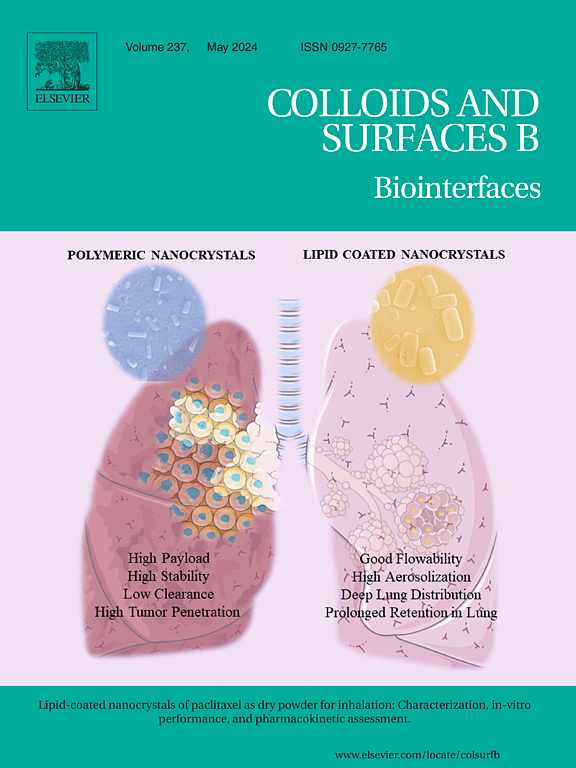皮克林乳液衍生聚合物微球:具有可调释放和比色传感的花青素保护载体
IF 5.6
2区 医学
Q1 BIOPHYSICS
引用次数: 0
摘要
天然化合物,如花青素,作为聚合物复合材料的可行成分很少受到关注,但它们可以使下一代的环境“意识”材料成为可能。花青素可以在不同的环境条件下改变颜色,但容易迅速降解。这项工作的目的是将花青素封装到由皮克林乳液产生的聚合物微球中,以增强其抗降解的稳定性,同时保持其抗氧化潜力。此外,我们的目标是生产有用的环境响应材料,基于实际应用的天然化合物,如比色传感器。经包封后,花青素主要以黄离子形式存在,形成荧光微球。对其包封效果和释放行为进行了评价。微球的花青素含量可达0.24 mg × g−1。花青素可以从微球中释放出来,这取决于溶液组成和环境触发因素,最高可达其满载容量的23% %。我们评估了包封的花青素的抗氧化活性,并证明包封后的抗氧化活性保持在90% %以上。我们还制作了一种生物相容性聚乙烯醇基复合材料的原型,并展示了其作为盐酸和氨气比色传感器的潜力。因此,我们证明聚合物微球是花青素的有效载体,提供防止降解的保护,同时表现出对环境条件的响应性。本文章由计算机程序翻译,如有差异,请以英文原文为准。
Pickering emulsion-derived polymer microspheres: Protective carriers for anthocyanins with tunable release and colorimetric sensing
Natural compounds, such as anthocyanins, have received little attention as viable components in polymer composites, but they could enable the next generation of environmentally “aware” materials. Anthocyanins can change colors in different environmental conditions, but are prone to quick degradation. The aim of this work is to encapsulate anthocyanin into the polymer microspheres, generated from Pickering emulsions, to enhance their stability against degradation while preserving their antioxidant potential. Further, we aim at producing useful environmentally responsive materials, based on natural compounds for practical applications, such as colorimetric sensors. Upon encapsulation, anthocyanin is mainly found as flavylium cation, resulting in fluorescent microspheres. The encapsulation efficiency and release behavior were assessed. The microspheres can be loaded with up to 0.24 mg × g−1 anthocyanin. Anthocyanin can be released from microspheres, depending on the solution composition and environmental triggers up to 23 % of their fully loaded capacity. We evaluate the antioxidant activity of the encapsulated anthocyanins and demonstrate that this is retained to more than 90 % post-encapsulation. The microspheres loaded with anthocyanin change color function of solution pH. We also prototype a biocompatible polyvinyl alcohol-based composite with anthocyanin encapsulated polymer microspheres and demonstrate its potential as a colorimetric sensor for hydrochloric acid and ammonia gases. Thus, we demonstrate that polymer microspheres are effective carriers for anthocyanins, providing protection against degradation while exhibiting responsiveness to environmental conditions.
求助全文
通过发布文献求助,成功后即可免费获取论文全文。
去求助
来源期刊

Colloids and Surfaces B: Biointerfaces
生物-材料科学:生物材料
CiteScore
11.10
自引率
3.40%
发文量
730
审稿时长
42 days
期刊介绍:
Colloids and Surfaces B: Biointerfaces is an international journal devoted to fundamental and applied research on colloid and interfacial phenomena in relation to systems of biological origin, having particular relevance to the medical, pharmaceutical, biotechnological, food and cosmetic fields.
Submissions that: (1) deal solely with biological phenomena and do not describe the physico-chemical or colloid-chemical background and/or mechanism of the phenomena, and (2) deal solely with colloid/interfacial phenomena and do not have appropriate biological content or relevance, are outside the scope of the journal and will not be considered for publication.
The journal publishes regular research papers, reviews, short communications and invited perspective articles, called BioInterface Perspectives. The BioInterface Perspective provide researchers the opportunity to review their own work, as well as provide insight into the work of others that inspired and influenced the author. Regular articles should have a maximum total length of 6,000 words. In addition, a (combined) maximum of 8 normal-sized figures and/or tables is allowed (so for instance 3 tables and 5 figures). For multiple-panel figures each set of two panels equates to one figure. Short communications should not exceed half of the above. It is required to give on the article cover page a short statistical summary of the article listing the total number of words and tables/figures.
 求助内容:
求助内容: 应助结果提醒方式:
应助结果提醒方式:


